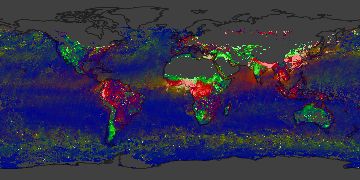
 |
||
|
|
||
| View other datasets |
|
|
| ||
 |
|||
| Coverage of this dataset spans November 2000 to February 2006. | |||
The animation features of the Earth Observatory are currently unavailable. We apologize for the inconvenience. To view the full temporal span of this dataset, please view the Aerosol Particle Radius monthly holdings. | |||
 Product description: Scientists use data from the MODIS sensor to measure the relative size of aerosol particles -- solid or liquid particles suspended in the atmosphere. Some aerosols are of natural origin (such as dust, volcanic ash, and sea salts) and some are produced by humans (such as smoke from fires, industries, or automobiles). This false-color image is a map of where there are natural aerosols (green pixels), human pollution (red pixels), or a mixture of both (light brown pixels). This is a new product, uniquely produced by the MODIS Team. By carefully quantifying how much visible and near-infrared sunlight an aerosol plume reflects back up into space, scientists can accurately estimate the average size of the individual aerosol particles within the plume. Aerosol particles of natural origin (such as windblown dust) tend to be larger in size than human-produced aerosol, which mostly originate from the process of combustion (from fires or factories) and are therefore broken down into smaller particles. Aerosols are scientifically important because they represent an area of great uncertainty in efforts to understand and predict global climate change. Moreover, they can influence rainfall patterns as well as cause respiratory problems in humans and animals. Every day over the entire planet, MODIS measures the amount of visible and infrared light that is absorbed within the atmosphere and how much is reflected back up into space. Scientists use these measurements to estimate the location and size of aerosol particles present in the atmosphere. The image above represents the average aerosol particle size distribution over the Earth for the month indicated. Image courtesy Reto Stockli, Earth Observatory, based upon data provided by the MODIS Science Team, NASA Goddard Space Flight Center
|
|
Subscribe to the Earth Observatory About the Earth Observatory Contact Us Privacy Policy and Important Notices Responsible NASA Official: Lorraine A. Remer Webmaster: Goran Halusa We're a part of the Science Mission Directorate |